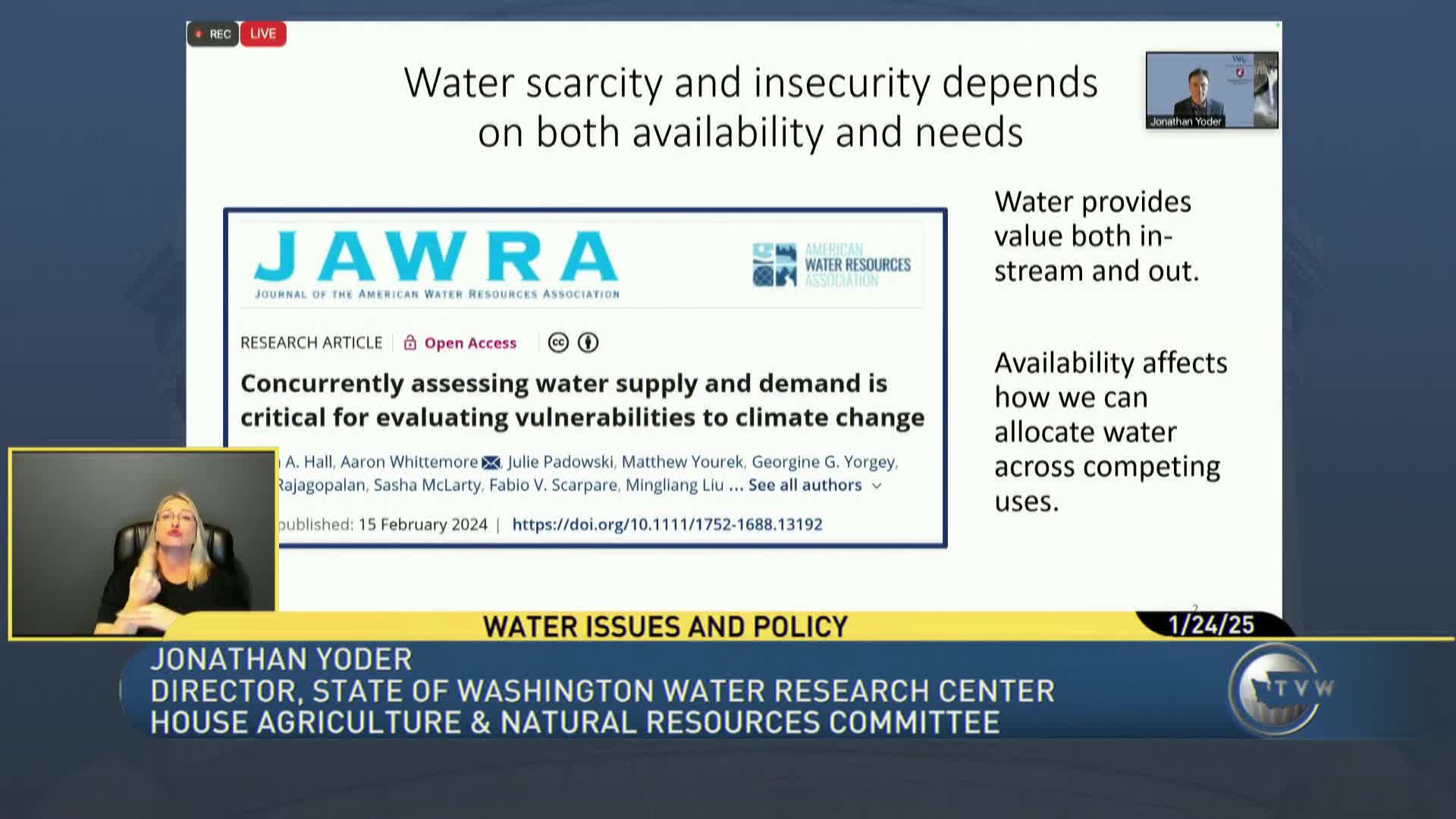Washington State explores innovative water management strategies amid growing scarcity concerns
January 24, 2025 | Agriculture and Natural Resources, House of Representatives, Legislative Sessions, Washington
This article was created by AI summarizing key points discussed. AI makes mistakes, so for full details and context, please refer to the video of the full meeting. Please report any errors so we can fix them. Report an error »

The House Agriculture & Natural Resources Committee convened on January 24, 2025, to discuss critical issues surrounding water scarcity and management in Washington State. The meeting focused on the intersection of water availability, needs, and usage, emphasizing the importance of streamflow for ecological health and water supply.
The discussion began with an overview of the essential roles of streamflow, which supports fisheries, wildlife habitats, and recreational activities. The committee acknowledged the potential impacts of climate change on streamflow, highlighting the need for adaptive water management strategies.
Key statistics were presented regarding water withdrawals in Washington State. Approximately 60% of water is used for irrigation, primarily in agricultural areas serviced by major water supply projects like the Columbia Basin and Yakima Basin Projects. Public water supply accounts for about 20% of withdrawals, with the remaining 20% divided among various other uses. The committee noted that while public water use has been growing, it has done so at a slower rate than population growth, attributed to improved water use efficiency.
The meeting also addressed the role of exempt wells, which provide water for rural domestic use outside public utility districts. Although these wells represent a small portion of total water use, they are significant from a legal perspective, especially as many basins are fully appropriated and new water rights are rarely issued.
The committee discussed the increasing challenges posed by climate change, which is expected to exacerbate water scarcity and insecurity, particularly during summer months. However, advancements in water use efficiency in both agricultural and domestic sectors were highlighted as a positive trend. The need for flexibility in water allocation was emphasized, with suggestions for retiming streamflow and facilitating water transfers to meet emerging demands.
Innovative solutions such as water banks and market platforms for water transfers were explored as potential strategies to alleviate the economic impacts of drought. The committee noted the establishment of approximately 40 water banks in Washington and the recent execution of an options contract between irrigation districts as examples of progress in water market development.
In conclusion, the meeting underscored the importance of adaptive management and technological advancements in addressing water scarcity challenges. The committee plans to continue exploring these strategies to ensure sustainable water use in Washington State.
The discussion began with an overview of the essential roles of streamflow, which supports fisheries, wildlife habitats, and recreational activities. The committee acknowledged the potential impacts of climate change on streamflow, highlighting the need for adaptive water management strategies.
Key statistics were presented regarding water withdrawals in Washington State. Approximately 60% of water is used for irrigation, primarily in agricultural areas serviced by major water supply projects like the Columbia Basin and Yakima Basin Projects. Public water supply accounts for about 20% of withdrawals, with the remaining 20% divided among various other uses. The committee noted that while public water use has been growing, it has done so at a slower rate than population growth, attributed to improved water use efficiency.
The meeting also addressed the role of exempt wells, which provide water for rural domestic use outside public utility districts. Although these wells represent a small portion of total water use, they are significant from a legal perspective, especially as many basins are fully appropriated and new water rights are rarely issued.
The committee discussed the increasing challenges posed by climate change, which is expected to exacerbate water scarcity and insecurity, particularly during summer months. However, advancements in water use efficiency in both agricultural and domestic sectors were highlighted as a positive trend. The need for flexibility in water allocation was emphasized, with suggestions for retiming streamflow and facilitating water transfers to meet emerging demands.
Innovative solutions such as water banks and market platforms for water transfers were explored as potential strategies to alleviate the economic impacts of drought. The committee noted the establishment of approximately 40 water banks in Washington and the recent execution of an options contract between irrigation districts as examples of progress in water market development.
In conclusion, the meeting underscored the importance of adaptive management and technological advancements in addressing water scarcity challenges. The committee plans to continue exploring these strategies to ensure sustainable water use in Washington State.
View full meeting
This article is based on a recent meeting—watch the full video and explore the complete transcript for deeper insights into the discussion.
View full meeting
